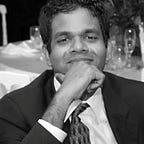Economics for Ordinary People
How much money?
On Money Supply, Inflation, Growth
Money Supply
Consider a small country populated by farmers and fishermen. Suppose this country uses gold as money (for those who’ve read What is Money?, this would be a Money 1.0 country). The farmers and fishermen would use gold to buy rice and fish.
Suppose a sack of rice cost one gold coin, and one gold coin bought you 10 fish (or 0.1 gold coins per fish). Also, suppose that there were 100,000 gold coins in the country. Economists refer to this “100,000” as the money supply in the country.
Now suppose that someone discovered a vast treasure of another 100,000 gold coins. And suppose, in a rare generous spirit, she decided to divide the booty amongst all her countrymen in proportion to their existing wealth. Since the size of the treasure (100,000) was equal to the current money supply (100,000), everyone’s wealth doubled.
Overall, the country now has 200,000 gold coins in circulation. In other words, the money supply has doubled.
Spending and Inflation
What would the doubling of money supply do to the prices of rice and fish?
Let’s suppose that the total quantity of rice and fish produced remains the same. And let’s also suppose that all rice and fish produced is sold with no waste.
Let’s also suppose that after the doubling of the money supply, everyone decided to spend their newfound wealth on rice and fish. We effectively have double the amount of gold “chasing after” the same amount of rice and fish. The price of rice and fish would double. A sack of rice would cost 2 gold coins, and a gold coin would now buy you only 5 fish (at 0.2 gold coins per fish).
This “increase in prices” is known as inflation.
Saving
Suppose that when the treasure was discovered, and the finder generously divided the booty amongst everyone, everyone decided not to spend the additional money. Instead, suppose everyone decides to save the money by burying it underground.
Now, while the country has 200,000 gold coins, the increase in money supply is not used for spending. Hence, we have the same amount as gold before, “chasing after” the same supply of rice and fish. Hence, prices would remain the same, and there would be no inflation.
Growth and Consumption
Suppose the country’s fishermen found a new and more efficient way of fishing. As a result, suppose they can now catch twice as many fish as before. Finding more efficient ways to produce goods (like fish and rice) and services is known as “Growth”.
Now, let’s suppose that the country’s people like to eat more fish. And with the doubling of supply, they are happy to eat twice as many fish as before. In this way, “Growth” is usually accompanied with increase “consumption”.
Questions for future articles
- What do economists mean by reserve, narrow and broad money supply? (The money supply described in our simple example is known as “reserve money supply” by economists)
- How is finding a treasure in our simple Money 1.0 country different from a central bank printing money in a complicated Money 3.0 country?
- What other things (besides increased money supply) cause inflation?
- After the fishermen found a better way to fish, people could buy more fish. So, does growth cause deflation?
- How do you encourage people to spend more or save more?
